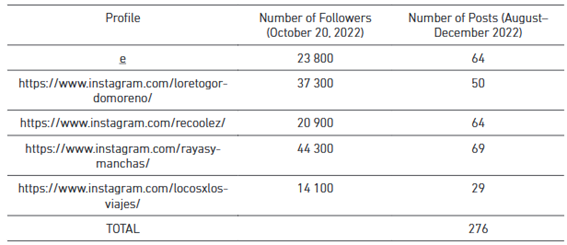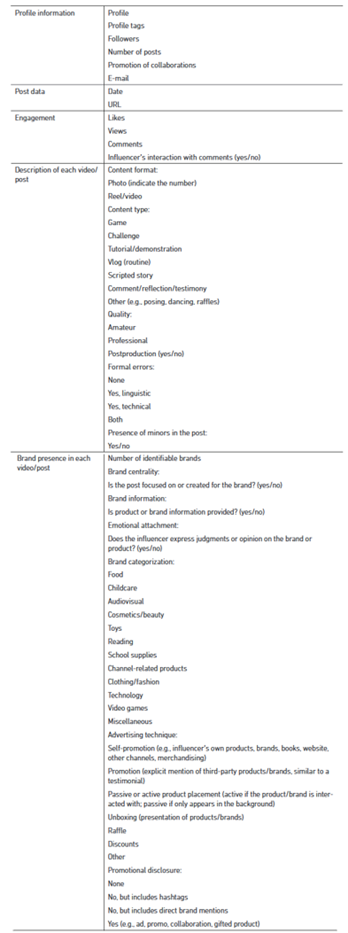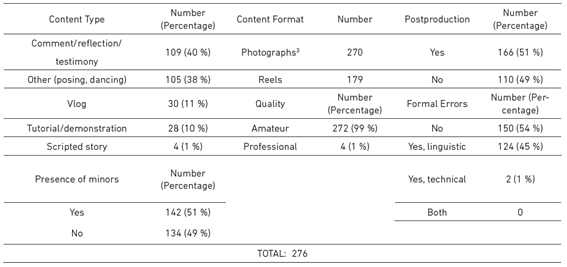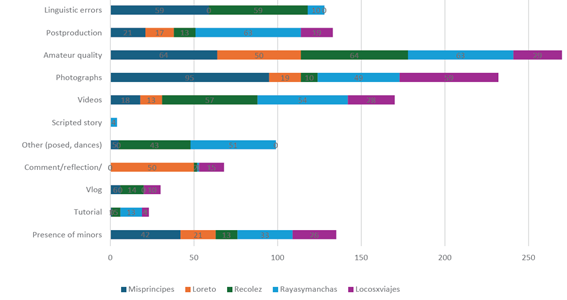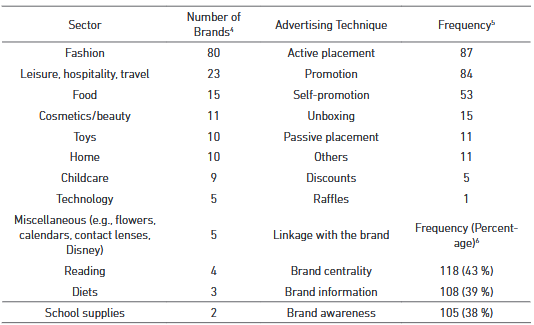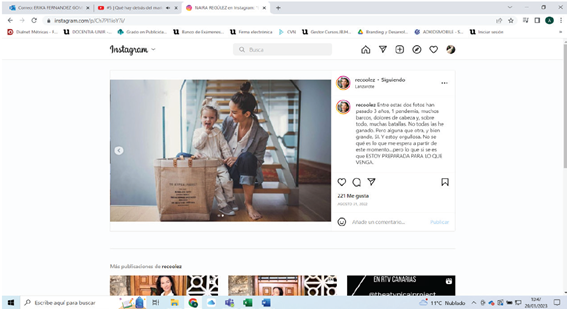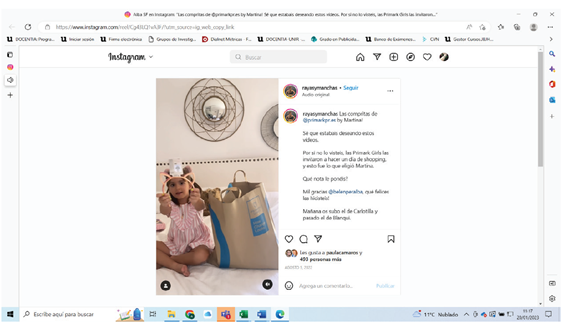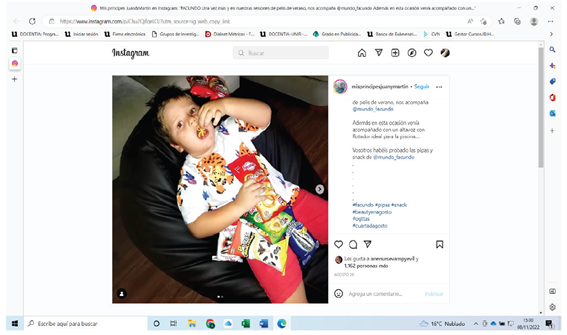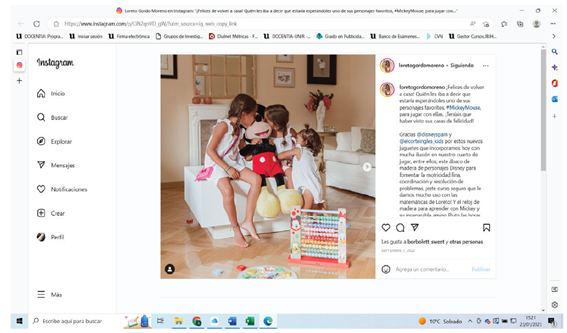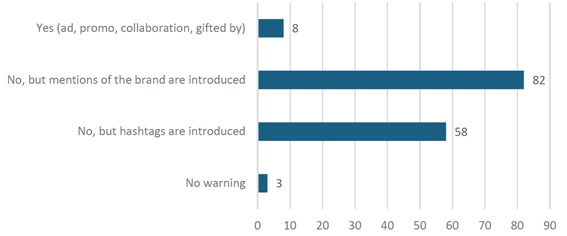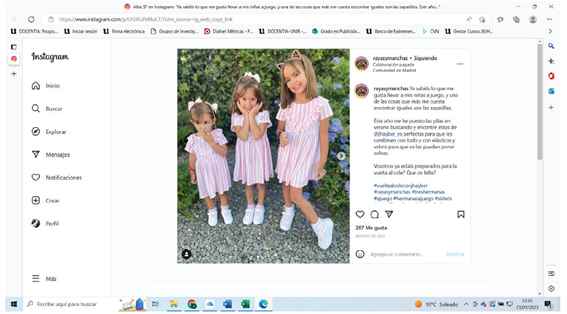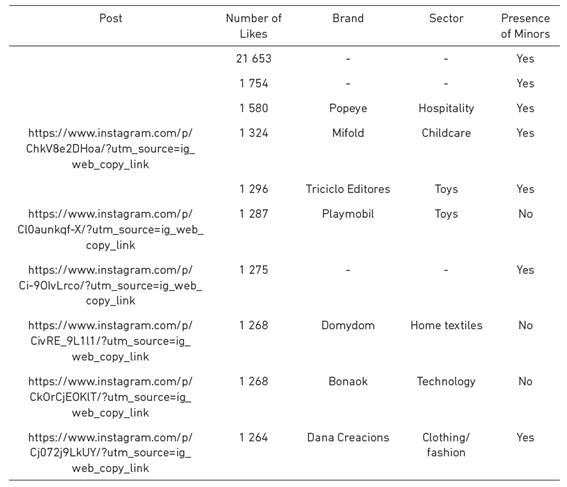INTRODUCTION
Influencer marketing has become a fundamental tool in advertising. In Spain, investment in influencer marketing has steadily increased (Infoadex, 2023). This activity combines social media platforms as advertising spaces with individuals—such as opinion leaders or well-known personalities like endorsers or influencers—to whom brands target their communication efforts to reach more potential consumers. The key benefit highlighted by brands is the ability to create authentic content related to them (Linqia, 2017). Recently, advertisers have shown growing interest in micro-influencers, individuals with a small but highly engaged community of followers, typically ranging from 10 000 to 100 000, who can exert significant influence over their audience (Tarifa & Cárdaba, 2022).
On the other hand, the presence of minors on social media has become widespread due to their participation as content creators (Feijoo & Fernández Gómez, 2021; Fernández-Gómez et al., 2021 a, 2021 b; Tur-Viñes et al., 2019) —in roles such as youtubers, instagrammers, or tiktokers—as well as their appearance on their parents’ channels (Jiménez Iglesias et al., 2022).
Despite the age restrictions—usually starting at 13 years—to access social media platforms such as YouTube, Instagram, TikTok, or Facebook, minors not only consume these digital contents but also actively create them (López Bolás et al., 2022; Tur Viñes et al., 2018), becoming influencers themselves. An influencer is someone who has many followers and the ability to make an impact within the digital community (Riccio et al., 2022).
Both in academic circles and society in general, concerns have emerged regarding potential violations of minors’ privacy (Holiday et al., 2022; Ranzini et al., 2020). This has given rise to the term “sharenting,” which describes the trend of parents sharing photos and videos of their underage children on social media (Elorriaga Illera et al., 2022). Also concerning is the use of minors to generate financial gain, especially through commercial relationships with brands, which are not always clearly disclosed (Núñez-Cansado et al., 2021). These issues are further complicated by the absence of a robust regulatory framework and the resulting consumer distrust.
A study by Asociación de Usuarios de la Comunicación (AUC - Association of Communication Users) and Comisión Nacional de los Mercados y la Competencia (CNMC - Spanish National Markets and Competition Commission) found that 84.6 % of advertising and promotional videos posted by influencers are covert commercial communications (Unión de Televisiones Comerciales en Abierto, 2022). Although the Asociación Española de Anunciantes (AEA - the Spanish association of advertisers) and the Asociación para la Autorregulación de la Comunicación Comercial - Autocontrol (the association for the self-regulation of commercial communication) introduced a code of conduct for the use of influencers in advertising in 2020, it remains insufficient, as it only applies to influencers who have signed the code (Asociación Española de Anunciantes & Autocontrol, 2022). Despite the proposal to use labels such as “#ads” to identify advertising content, many posts contain highly persuasive elements that are difficult to manage by more vulnerable audiences (Núñez-Cansado et al., 2021; Tur-Viñes et al., 2019).
In Spain Law 13/2022, dated July 7 and entitled ““Por la cual se regula la comunicación audiovisual de ámbito estatal” (general law on audiovisual communication), includes provisions that apply exclusively to the most prominent influencers, requiring them to comply with basic obligations concerning the general principles of audiovisual communication, protection of minors and users, and registration in the State Registry of Audiovisual Communication Service Providers. Additionally, influencers must adhere to Law 34/1988, dated November 11 and entitled “Por la cual la publicidad se rige por la Ley de Competencia Desleal y por las normas especiales que regulen determinadas actividades publicitarias” (general law on advertising), and Law 34/2002, dated July 11 and entitled “Por la cual se regula el régimen jurídico de los servicios de la sociedad de la información y de la contratación por vía electrónica” (Law on Information Society Services and Electronic Commerce).
Additionally, efforts have been made to regulate content aimed at more vulnerable audiences. For example, well-known personalities, including influencers, are prohibited from advertising food and beverages to audiences under 16, according to the Draft Royal Decree on the Regulation of Food and Beverage Advertising Targeted at Children (Ministerio de Derechos Sociales, Consumo y Agenda 2030, 2022). This decree defines these personalities as individuals with a high level of influence due to their large number of followers. It also prohibits any form of promotion aimed at children—such as prizes, gifts, contests, sweepstakes, or sponsorships—to support advertising of foods and beverages high in sodium, sugars, sweeteners, fats, and saturated fatty acids.
For the toy sector, the new Self-Regulation Code for Children’s Toy Advertising —signed by Ministerio de Derechos Sociales, Consumo y Agenda 2030, the Asociación Española de Fabricantes de Juguetes (AEFJ - the Spanish association of toy manufacturers) and Autocontrol— which came into effect on December 1, 2022, seeks to promote and fostering a plural, egalitarian, and stereotype-free image of children. The code discourages associating toys with specific gender roles and emphasizes the importance of influencers adhering to legislation and the correct identification of advertising content, following the code on the use of influencers in advertising established by AEA and Autocontrol (Asociación Española de Fabricantes de Juguetes, 2022).
One prominent example of an influencer in this space is Verdeliss, perhaps one of the most studied Spanish “instamoms,” i.e., influential mothers on Instagram (Zozaya-Durazo, L. & Sádaba-Chalezquer, 2022). Increasingly, more mothers have gained recognition by sharing their children’s images, videos, and stories on digital platforms (Jorge et al., 2022). These influencers earn income through collaborations with advertisers interested in reaching a key sector: motherhood or parenthood (Abidin, 2015). However, these relationships are not always transparent, and posts featuring minors generate the highest level of engagement, measured in interactions, likes, and comments (Jiménez Iglesias et al., 2022).
As a result, more anonymous individuals have followed in the footsteps of these major influencers and, even with a smaller community, they have managed to generate interest of brands due to their relevance to a particular group of followers.
Micro-influencers, also referred to as “micros” (Alampi, 2019), are individuals with fewer than 100 000 followers who are becoming increasingly effective (Kayser, 2022). Despite their smaller communities, they have a strong capacity to influence their audience. Their messages tend to be more targeted and personal, fostering a deeper sense of loyalty among their followers. The Top Digital Trends 2023 report highlights micro-communities as a key trend in brand communication, emphasizing the need for brands to engage with smaller, more diverse audiences by focusing on shared interests that create a strong sense of belonging (Iab Spain, 2023).
However, there is currently a lack of specific regulations addressing this type of influencers from an academic perspective (Marques et al., 2021). Their interest is evidenced by the fact that, even with modest followings, they often reflect their audience and maintain high levels of trust, authority, and authenticity, making them “the perfect formula for powerful influence” (Alampi, 2019, p. 203). According to Dinesh (2019), “the engagement levels drop as the social media follow numbers increase. Micro-influencers with 1 000 followers get about 4 % more engagement than influencers with 10 000 followers” (Challenges of Working with Influencers and the Benefits of Working with Micro-influencers section, para. 1).
The originality and uniqueness of micro-influencers’ posts are key factors for effective content marketing (Silalahi, 2021). One of their advantages is having a “real” relationship with their audience. Since followers identify with micro-influencers, they are more likely to follow their advice (Marques et al., 2021).
From an academic perspective, studies on micro-influencers remain limited, with existing research focusing on specific sectors, such as the hospitality industry in Portugal (Peres & Silva, 2021) and local brands in Indonesia (Silalahi, 2021). (Peres & Silva, 2021) further note that many of these micro-influencers are women with graduate degrees who have other jobs and do not collaborate with influencer agencies, highlighting a lack of professionalism in their activities.
According to 2btube —an agency specializing in reaching online audiences with audiovisual content creation and influencer representation— when a content creator surpasses 100 000 followers on any of their social media profiles, they achieve influencer status and can pursue this activity professionally by monetizing through advertising revenue (“En España hay más de 7500 influencers”, 2021). Some micro-influencers, who are already content creators with fewer than 100 000 followers, are fully dedicated to managing their social media.
Therefore, the novelty of this research lies in studying these small opinion leaders within a sector that, while concerning from the point of view of minors, is highly lucrative for brands, specifically influential mothers (Garrido et al., 2023).
This work demonstrates how advertisers, both large and small, are turning to a new type of content creator (Fernández-Gómez et al., 2024; Marchán Sanz et al., 2024)—micro-influencers in their role as mothers—to promote their products in a sector where main regulations apply to large opinion leaders. Micro-influencers, with their smaller audiences, enjoy greater freedom when communicating. However, we argue that both brands and content creators, whether macro or micro, should prioritize responsible and ethical communication with their audiences.
METHODOLOGY
This research analyzed the content types, brand presence, advertising techniques, and their association with the presence of minors among five Spanish-speaking micro-influencers in the motherhood sector.
The aim is to understand the communication and engagement strategies employed by these micro-influencers in the motherhood sector through an exploratory study of their social media activity. Specifically, the research seeks to identify content types and styles, the presence of minors and brands, and how they are disclosed on the platform.
Given the limited academic literature on micro-influencers, especially in Spain, this study proposes a first approach to this phenomenon through content analysis to understand their communication strategies (content types, posting frequency, brand presence, and transparency) and engagement levels (likes or views), as micro-influencers are often recognized for their high levels of audience engagement.
A content analysis was carried out, with a stronger emphasis on interpretation than quantitative measurement (Andréu, 2002). The study variables are shown in Table 2. This analysis sheet was developed based on previous studies (Farivar et al., 2022; Feijoo & Fernández-Gómez, 2021; Fernández-Gómez et al., 2021 a, 2021b; Jiménez Iglesias et al., 2022; Kim & Kim, 2023; Perez Curiel & Luque Ortiz, 2018; Pérez-Curiel & Sanz-Marcos, 2019). Therefore, the reliability of the content analysis is ensured by the use of an analysis framework that has been tested in previously published research articles (Feijoo & Fernández Gómez, 2021; Fernández-Gómez et al., 2021 a, 2021b). Additionally, a pretest was conducted to adapt the framework to the specific object of study.
The following research questions guided this analysis:
1) What content types do micro-influencers in the motherhood sector post? Does their style seem to be amateurish?
2) Are minors featured in the content they share?
3) Which brands are promoted? What advertising techniques are employed? Do they transparently disclose brand promotions to their audience?
Table 2 classifies the techniques used (Feijoo & Fernández-Gómez, 2021; Tur Viñes et al., 2018; Tur-Viñes et al., 2019) and provides descriptions of each (self-promotion, promotion, passive location, active site, unboxing, raffle, discounts, and others).
As shown in Table 2, transparency refers to whether the posts involving brands include some form of disclosure, such as hashtags, direct brand mentions, or formulas like “ad,” “promo,” “collaboration,” or “gifted product” (Feijoo & Fernández-Gómez, 2021; Fernández Blanco & Ramos Gutiérrez, 2024).
4) What characteristics do posts with higher engagement possess?
As defined in Table 2, engagement refers to audience interaction, measured by likes, views, and comments from followers, as well as whether the influencer replies to followers’ comments (Feijoo & Fernández-Gómez, 2021; Fernández Gómez & Martín Quevedo, 2018; Tur Viñes et al., 2018; Tur-Viñes et al., 2019).
According to Iab Spain and Elogia (2022), Instagram is the most widely used social media platform in Spain for following influencers, with 74 % of the population using it. The second most used platform, YouTube, is used by 54 %. In addition, the typical follower of digital influencers are women aged 25 to 40.
Therefore, this study focuses on micro-influencers on Instagram, specifically those with 3 000 to 80 000 followers, as defined by micro-influencer marketing platforms such as FuelYouBrands1. We propose analyzing the content of five influencers (Table 1) ranked by the influencer marketing platform Affable2. The analysis of the posted content covers five months, from August to December 2022, a sufficient timeframe to obtain results that yield exciting conclusions about these content creators. Previous studies have considered smaller samples, with one month of analysis (Feijoo & Fernández-Gómez, 2021; Fernández-Gómez et al., 2021 a, 2021b), while others have also studied five profiles to approach vegan influencers on Instagram (Romero-Cantero et al., 2022).
Sample
Below is a brief description of the profiles of the micro-influencers analyzed:
misprincipesjuanymartin: This profile belongs to a mother with two young children who describes herself as a blogger with two children focused on cosmetics and food. Her email is included in her profile for collaboration inquiries. Her posts feature her children, herself, or all three of them together. Most of her content is associated with food, home, or children’s brand. She mainly shares amateur photos with no postproduction and with many linguistic errors.
loretogordomoreno: The account of this 32-year-old woman centers on motherhood, family, travel, and lifestyle. Her photos and reels feature her three daughters (without showing their faces) and her husband. She is part of the PronoKal program (similar to Herbalife) and shares content related to fashion and beauty. In addition, she posts messages about her faith and love for God. The profile is aesthetically curated, with a link to her website (http://www.madeinstyle.es/) included in her Instagram bio.
recoolez: Creator of The Atypical Project, a handbag and luggage store that combines values, ethics, and aesthetics. Her Instagram bio includes her contact information and highlights her interests in motherhood, vintage fashion, fair trade, and sustainability. She is a mother of one and serves as a brand ambassador for Darphin Paris, with her posts focusing on second-hand fashion and how to make the most of it.
rayasymanchas: She introduces herself as Alba SF, a mother of three princesses, dentist, as well as travel, fashion, and party enthusiast. Professionally a dentist, she uses her account to share stories and photos of her family, travels, and lifestyle. Her posts feature her three daughters (aged 7, 5, and 3), highlighting the brands and clothes she promotes, especially Primark, for which she serves as an ambassador.
locosxlosviajes: This profile is a blog dedicated to travelling with children. Mari Carmen shares her travels with her partner and two daughters. The account is nourished by detailed stories, while her young children are typically featured from behind, avoiding direct exposure.
Method
The following variables, previously used in research on Instagram influencers, have been adapted for this study (Table 2).
Note. Adapted from Farivar et al., 2022; Feijoo & Fernández Gómez, 2021; Fernández-Gómez et al., 2021 a, 2021b; Jiménez Iglesias et al., 2022 ; Kim & Kim, 2023; López Bolás et al., 2022; Perez Curiel & Luque Ortiz, 2018; and Pérez-Curiel & Sanz-Marcos, 2019).
RESULTS
Content and Presence of Minors in the Posts of Micro-Influencers
During the analyzed period, in which five profiles were studied, 276 posts were collected. As shown in Table 1, all micro-influencers—except for the profile with the fewest followers (locosxlosviajes)—posted a similar number of entries, with an average of 55.2 posts per account and 11 monthly posts over the five months analyzed. This suggests that these profiles use social media occasionally.
Overall, as illustrated in Table 3, the posts generated by these influencers are primarily comments (109 posts; 40 %) and other content, such as posing, dancing, or sweepstakes (105 posts; 38 %), mostly shared through photographs (270 photos vs. 179 reels). It should be noted that only the videos posted on the wall were collected, as it was impossible to retrieve stories due to their 24-hour availability before disappearing.
In terms of content quality, most posts (272; 99 %) were of amateur quality. Although more than half of the photos and videos involved some postproduction (166 posts, 51 %), a significant portion (110 posts, 49 %) showed no management of audiovisual material. Postproduction was mainly applied to reels, where music, text, and video cuts were added.
Given the non-professional nature of the posts, linguistic errors were prevalent (124 posts; 45 %), with the most common mistakes being accentuation errors or misspellings.
Finally, minors appeared in slightly more than half of the posts made by these influencers (142 posts; 51 %).
Although the five profiles analyzed share a common focus on motherhood, each approaches it from a different perspective, which leads to variations in the content produced by each micro-influencer (Figure 1). For example, misprincipesjuanymartin and loretogordomoreno frequently post content centered around comments or reflections, while recoolez and locosxlosviajes often share vlogs, and rayasymanchas tend to post posed images.
Regarding the presence of minors, their representation varies depending on the micro-influencer. For example, in the case of misprincipesjuanymartin, minors appear in a significant number of posts (42 out of 64), with their faces clearly visible. In contrast, on profiles such as loretogordomoreno, although minors are also featured regularly (21 out of 50), they are usually only partially identifiable in the content.
The amateur quality of content is widespread across the profiles. As for postproduction, it is more common in accounts that share a higher volume of video content, such as rayasymanchas or locosxlosviajes. On the other hand, misprincipesjuanymartin and recoolez are the accounts with the highest frequency of linguistic errors.
Brand Presence, Transparency, Engagement, and Advertising Techniques
Brand Presence
During the analyzed period, a total of 177 brands were identified across the five micro-influencer profiles: 59 in misprincipesjuanymartin, 39 in recoolez, 32 in loretogordomoreno, 31 in rayasymanchas, and 16 in locosxlosviajes. This indicates that a brand was present in 54.71 % of the analyzed posts (151 out of 276). As shown in Table 4, a high number of these posts are dedicated to brand promotion, accounting for 43 % of the total analyzed (118 posts with these characteristics). Additionally, 39 % provide information about the brand (108 posts) and 38 % show a sense of attachment to the brand (105 posts). Regarding the advertising techniques employed, active placement was utilized in 87 instances, and promotion occurred 84 times, making these the most frequently used advertising formats. Influencers typically appear either using the products they promote or alongside their children, accompanying their posts with positive information and feelings toward the advertiser. Self-promotion is also evident, especially when recoolez promotes her own company.
As illustrated in Table 4, the fashion sector is represented by a significant number of brands, totaling 80. This is especially noticeable in the recoolez profile, where most featured brands fall within this category due to the account’s focus on promoting her handbag company, The Atypical Project (Figure 2). In addition to this self-promotion, several other adult brands, such as Rosa Delgado, Castañer, and Bobo’s, are also highlighted. Similarly, the loretogordomoreno profile (Figure 3) showcases both adult fashion brands, including Slowlove or Alawa Swimwear, and children’s brands like Hipercor or Petite Coppelia. Furthermore, the rayasymanchas account includes multinational companies such as Primark (Figure 4), where the influencer promotes various categories of the company, including clothing, home goods, and beauty products. This micro-influencer also includes brands from the Inditex group, such as Pull&Bear and Zara, in her social media content.

Figure 3 Active Placement of Three Brands from Different Sectors (Smileat, Tutete, and Hipercor) on the Loretogordomoreno Profile
Other sectors with a notable presence in the analyzed accounts include leisure, hospitality, and travel (23 brands); food (15 brands); cosmetics/beauty (11 brands); toys and home (10 brands); and childcare (9 brands). In the leisure, hospitality, and travel sectors, the locosxlosviajes profile stands out. Given the account’s focus, it features travel-related brands such as Heymondo, a travel insurance company, themed attractions like Aventurico Madrid Escape Room, and Micropolix, a children’s leisure center.
The food sector is especially prominent in the misprincipesjuanymartin profile, where most posts are created to promote various brands. Well-known companies such as Facundo (Figure 5), Trapa, and Dulcesol are frequently showcased, sometimes in strange contexts where children appear posing with the products. Additionally, several local brands of sweets and candies, such as Golosinas Superbelén and La Palmería, are featured. Advertisers face significant restrictions in traditional advertising due to the global problem of childhood obesity. This challenge is expected to intensify with the forthcoming draft regulation on food advertising aimed at children in Spain, which will impose further limitations on promotional activities.
In the cosmetics/beauty sector, the Darphin Paris brand is prominently featured by the micro-influencer recoolez, who serves as an ambassador for the company. Approximately once a month, she shares a post showing how she uses some of its products. Another well-known brand is Nelly’s, which is promoted in two posts by misprincipesjuanymartin. It is evident that these advertisers are targeting an adult audience.
The home sector is represented across all profiles except for locosxlosviajes. It is more common in accounts like misprincipesjuanymartin or loretogordomoreno, where they often showcase their homes through images or room tour videos. Featured brands include Don Algodón (home textiles), Domydom (home textiles), and Del Arco Hogar (furniture), among others, which enhance both the influencers’ beds and those of their children (Figure 6).
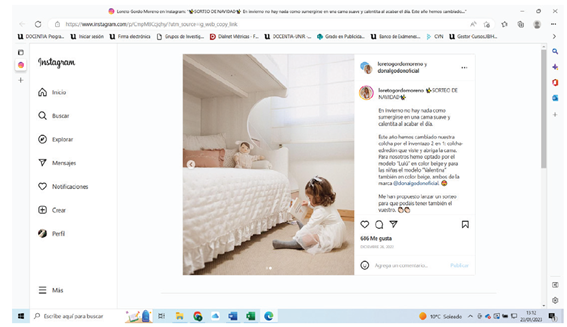
Figure 6 Passive Placement and Promotional Draw of the Don Algodón Brand on the Loretogordomoreno Profile
In these two accounts, toys are prominently featured, with 80 % of the brands promoted during November and December, aligning with the Christmas campaign. Furthermore, eight out of the 10 posts related to this sector belong to the misprincipesjuanymartin profile. Consequently, significant advertisers such as Playmobil, Bizak, El Corte Inglés, and Aldi are represented (Figures 7 and 8).
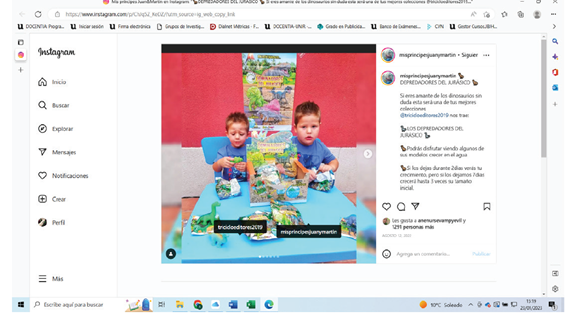
Figure 7 Active Placement of Triciclo Editores Toy-Selling Publishing House on the Misprincipesjuanymartin Profile
Transparency
As illustrated in the previous section, brands are prominently featured in the profiles of the analyzed micro-influencers without any disclosure of commercial collaboration. Although brands are mentioned or tagged for quick identification, there is often no clear disclosure that the post is paid for or sponsored by a brand or that the product was gifted by the brand. The commercial relationship has been explicitly clarified in only eight posts featuring brand mentions (Figure 9 ).
Engagement
The 10 most-commented posts are all associated with sweepstakes, which makes sense as participants are encouraged to comment and mention a follower to increase the post’s reach. Notably, nine out of these 10 posts are from the misprincipesjuanymartin profile, which has the highest presence of brands. The remaining post is from loretogordomoreno, a sweepstakes for the Don Algodón brand. This highlights how user participation is driven by the chance of winning the advertised product or service.
As shown in Table 5, only two brands—Playmobil and Siberian Wellness—target children, and the rest appeal to the adult audience. In these cases, minors just appear twice, while the other posts feature images of the products themselves.
When examining the number of likes, the most popular posts show greater diversity. While sweepstakes are included among the 10 most-commented posts (three of which are among the most-commented posts in Table 6), other messages encouraged user engagement through comments. Notably, the two most popular posts do not feature any brand presence. The most-liked post belongs to recoolez, showcasing a vlog of her daughter’s daily routine with her dogs. The second most-liked post is from rayasymanchas, featuring a reel in which her daughters welcome a kitten, also without any commercial collaboration. Furthermore, the most-liked posts exhibit a higher presence of minors compared to the most commented ones.
The remaining top posts primarily come from the misprincipesjuanymartin profile, highlighting products for adults (hospitality, home textiles, and technology) as well as items for children (toys and childcare). Among the top 10 most-liked posts, a set of three photographs of misprincipesjuanymartin with her eldest son, in which she poses while pregnant, stands out and does not feature any brand presence.
CONCLUSIONS
This research addresses a well-known and extensively studied topic: the significance of influencer marketing within the motherhood sector and the Instagram social media platform. However, it focuses on a figure yet to be fully explored by both the sector and academia: micro-influencers, i.e., influencers with less than 100 000 followers who have highly engaged communities and attract the interest of brands.
We have examined profiles that share characteristics with other well-known instamoms with over 100 000 followers (e.g., verdeliss, ohmamiblue, trimadredeprincesas). These influencers share content related to their family life on Instagram, frequently featuring their young children, and regularly collaborate with brands (Jiménez Iglesias et al., 2022). A distinguishing feature of micro-influencers is their amateur content, with postproduction limited to videos and many linguistic errors—such as misprincipesjuanymartin and recoolez— which create a sense of closeness and reveals the lack of professionalization of these profiles. Like larger instamoms, the profiles analyzed include brand collaborations through different types of advertising techniques (sweepstakes, promotions, placements), but they share a common lack of transparency regarding the nature of their commercial relationship. This ambiguity leaves it unclear what the influencer gains, while the brand seeks notoriety either through direct mentions (e.g., @jhayber_es) or the creation of branded hashtags (e.g., #vueltaalcoleconjhayber).
The commercial interest of these influencers is twofold, as they can engage both adult and child audiences, although parents ultimately decide what products their children consume. The studied profiles featured brands from sectors such as fashion, leisure, hospitality, food, cosmetics/beauty, and toys. Particularly concerning is the presence of brands promoting unhealthy food products, which could be restricted with the forthcoming draft regulation on food advertising aimed at children. Posts featuring brands usually include product information alongside the influencer’s feelings or opinions about the product or service being promoted.
Minors play an essential role, often appearing in posts that receive the most likes and branded content. Some profiles, such as loretogordomoreno or locosxlosviajes, show a more moderate exposure of minors, avoiding direct identification, while others, like misprincipesjuanymartin, display higher levels of child exposure, particularly in connection with brands.
The profile with the highest follower count, misprincipesjuanymartin, has the strongest engagement, with the most-commented posts (sweepstakes) and likes. Its most popular posts are daily updates that do not feature brand presence. This is surprising given the account’s numerous linguistic errors—as previously mentioned—yet it has significant brand relationships and high level of child involvement, highlighting the sense of authenticity and closeness to the community that advertisers seek.
The involvement of minors in advertising raises ethical concerns, particularly when mothers promote products that are subject to regulation in children’s advertising, such as product placement, undisclosed promotions, and advertising of unhealthy products. Although parents may be the immediate recipients of these messages, the products are ultimately consumed by their children.
LIMITATIONS AND PRACTICAL IMPLICATIONS
Micro-influencers are ordinary individuals who use social media to get followers and attract advertisers. Their profiles often feature promotions like those of larger influencers, making it crucial to be aware of advertising disclosure. Despite a scarcity of information in the literature on micro-influencers, this exploratory analysis provides an initial understanding of these opinion leaders. Various topics were addressed to deepen our understanding of this topic, indicating a need for further study in this area.
This research focuses on analyzing the relationship between micro-influencers and brands, as well as the involvement of minors. Although the methodology used was appropriate and yielded satisfactory results, it is important to note that this is a preliminary approach to a nationally addressed phenomenon. The study was conducted over a specific period and with a limited sample. Therefore, it is recommended to extend this research by including micro-influencers from other nationalities and analyzing data over a longer timeframe.
It would also be interesting to enhance the descriptive analysis with interviews from the perspective of micro-influencers. Understanding the sphere of influence of these personalities enables brands and marketers to effectively broaden their audience. The study of smaller communities on social media should continue, given their commercial interest and the need to ensure ethical and transparent communication with their audiences.
To foster responsible industry practices, advertisers should prioritize ethical conduct and avoid making formal errors in their posts. In the interest of transparency, influencers should always disclose advertising collaborations. Regarding Instagram, the platform should prohibit the systematic involvement of minors and the promotion of unhealthy products, similar to regulations in traditional media. These considerations are important for future research, particularly concerning micro-influencers.
Additionally, Fernández Blanco and Ramos Gutiérrez (2024) already argue that mega-influencers tend to involve minors less frequently than micro- and macro-influencers. This is largely due to the need for legal compliance faced by mega-influencers, whose huge follower count and heightened public visibility place them under greater social and regulatory scrutiny.














